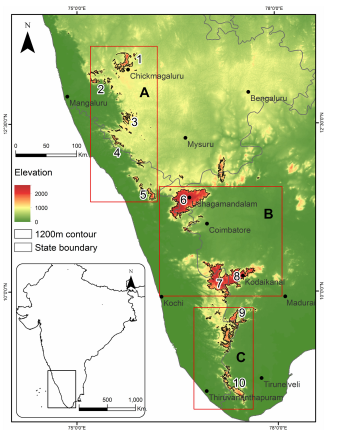Invasion compounds an ecosystem-wide loss to afforestation in the tropical grasslands of the Shola Sky Islands
Tropical montane habitats, including the Shola Sky Islands in the Western Ghats, host several threatened taxa of which, the global distributions are restricted to these mountain-tops. The rapidly increasing human footprint and the spread of invasive alien plants have already resulted in the local extinction of several taxa. Here we examine the entire Shola Sky Islands ecosystem to estimate the extent of habitat lossand to create a baseline of land use in this rapidly changing landscape. We used LANDSAT imageries from 1973, 1995 and 2017, with 840 ground truth points across the ecosystem. We find substantial landscape modification in the large high elevation plateaus (7–60%) over the last four decades while changes are muted in the other parts. The loss of grasslands to exotic trees predominates (340 km2, 23%) the modification of this landscape, and, continues today at a rapid pace. Contrary to popular belief, Shola Forests have been relatively stable, implying that most plantations were established on grasslands—traditionally classified as “unproductive wastelands”. Across the Protected Area (PA) network, Reserve Forests (RF), the least protected areas have faced the greatest loss of grasslands. Older PAs have lost relatively fewer grasslands, but the invasion from adjoining RFs is now increasing. We highlight the complexity of conservation in this landscape with three case studies of PAs with different management histories. Our study highlights the rapid loss of native Shola Grasslands, the continuing loss to invasive exotic trees, and the challenges of conserving this critical habitat with traditional modes of conservation.
